
Summarize Content With:
Quick Summary
In this blog, we are going to know how outbound software has changed the user interaction and solving user’s queries. Here we are going to know how such tedious and repetitive tasks can be done more effectively using automated outbound calling software and increase operational efficiencies too. With botphonic you can grow and scale at the same time, without any additional costs.
Introduction
Getting tired of calling customers and getting yelled at, without any real reason? Don’t worry, we have automated outbound calling software here to help you with such a boring task. Now you can answer those same repetitive questions with a smart AI call assistant effectively, without even having to face those frustrated leads.
Outbound calls are known as calls done by companies to other users and convert them into potential leads or even customers. It expresses the journey of offering your product or service to interested users and letting them make the decisions.
What Is Outbound Calling?
An outbound call refers to the calls made by businesses to interact with customers or with those potential leads who have shown interest in their product. These calls are often made to introduce their products, sales, marketing, customer service, or even for research purposes to gather relevant information.
Usually, it was made by brand agents or representatives to interact with the customer and help them. Even though these brand agents and representatives are still present they are not the same anymore. Earlier, these agents were human, but in this advanced world of technology, virtual assistants or AI call assistants are being used to interact with those potential leads.
What Is Automated Outbound Calling Software?
An automated outbound calling software is used to initiate calls to potential leads, which helps automate the process of outgoing calls to those consumers. It reduces the workload by removing the need for manual dialing. The software helps effectively manage call lists, dial numbers, and escalates the call to human reps if needed.
Top 5 Key Features and Functions
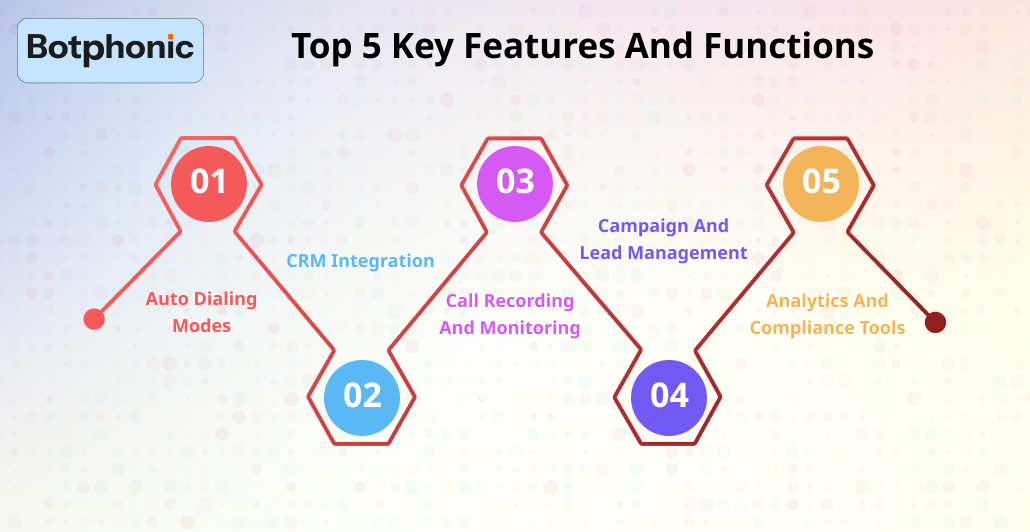
Even though it’s software, there are various key features and functions offered by outbound calling solutions. Some of the features are as follows:
1. Auto Dialing Modes
Several automated dialer software programs help in making even AI agents work easier, such as:
- Predictive Dialer: A Call center predictive dialer helps dial multiple numbers based on the agent’s schedule and stats to reduce idle time.
- Power Dialer: Using power dialer software enables AI agents to dial numbers in a specific manner for human reps, which is generally useful for targeted campaigns.
- Preview Dialer: Allows agents to prepare if there’s any need and shows contact details before dialing.
- Progressive Dialer: Before initiating the call to the user, it looks out for agents’ availability to reduce the waiting time.
2. CRM Integration
CRM integration allows software to initiate personalized calls, track interactions, and even help streamline workflows. With CRM integration in outbound calling, enabling access to contact data and updating records allows human reps to focus on other tasks.
3. Call Recording and Monitoring
Allows agents to schedule calls for follow-ups or even for specific time slots, resulting in improved engagement rates. Enabling recording, live monitoring, and even whisper coaching for training becomes easy.
4. Campaign and Lead Management
Outbound software helps organize contacts and also enables scoring the leads based on their interaction. It further helps in prioritizing leads and follow-ups.
5. Analytics and Compliance Tools
Using call analytics software to track key metrics of calls, such as duration, connect rate, conversion rate, and even how the agent is performing in real-time, helps analyze and curate a suitable strategy further. It ensures compliance with local and international regulations by filtering out registered DNC-listed numbers.
How Automated Outbound Calling Software Works?
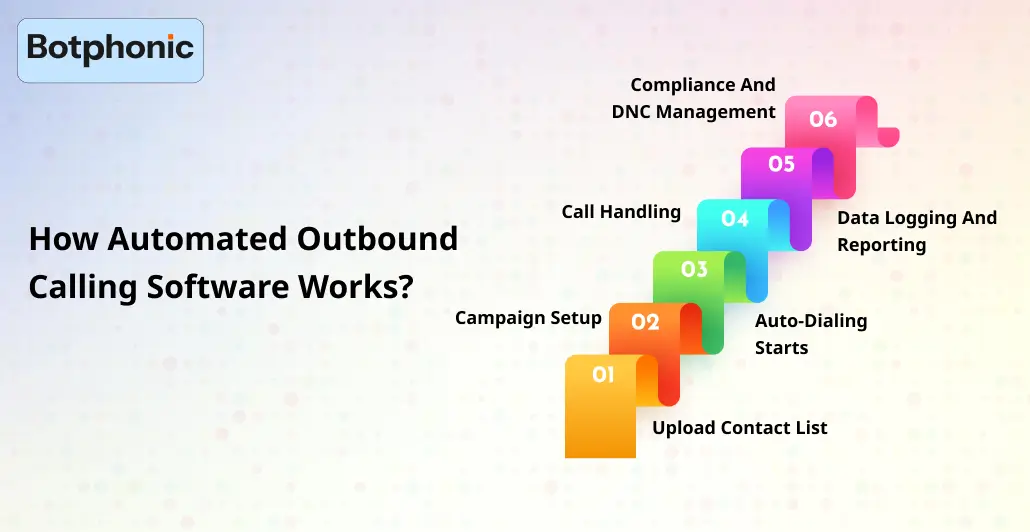
Now that we know what an automatic outbound call is and how it makes outbound calling easier, how about we know its workflow. Integrating CRM calling software in your business and campaign automation will help you achieve your goals. Here’s how it generally works:
1. Upload Contact List
Start by adding a list of contact digits of leads into the calling software, which is often received from CRM or a spreadsheet.
2. Campaign Setup
You can use an inbound and outbound call center to create a campaign setup, which allows you to set objectives, call scripts, schedule preferences, and even assign agents.
3. Auto-Dialing Starts
Using call center dialer software helps you with auto-dialing from the list shared above by selecting the suitable dialing mode.
4. Call Handling
After connecting, AI agents use scripts added to the data and access through CRM data. If the call isn’t answered, it can lead to several options such as:
- Leave a pre-recorded voicemail
- Reschedule the call
- Or just move to the next number.
5. Data Logging and Reporting
Cloud-based call center software provides real-time compliance, automatically saves call outcomes, notes, and even recordings. It shares real-time data about call volume, agent performance, conversion rates, and even compliance stats.
6. Compliance and DNC Management
The software ensures to check the number before taking any actions against Do Not Call (DNC) compliance and follows regional regulations too.
Call center automation software too automated dialing and further helps connect the calls to the right agents. Then proceeds to record results and provide insights which are actionable to make it better than earlier. It all becomes a centralized process, or often using a cloud-based platform campaign.
3 Smart Strategies to Implement Outbound Calling Automation
Just as impressive features and functions, there are fascinating strategies too, which help enhance the outcome and make the implementation of lead generation, outbound calling, and even automation easier. Here’s a breakdown of 3 smart strategies to implement these automated outbound calls.
1. Categorize and Prioritize Your Leads
Using call center software can help you segment your leads and prioritize in real-time. Use your CRM to classify them based on industry, locations, behavior, or the stage they are in. Prioritizing them makes it easier for you to recognize potential leads and boosts engagement, too.
2. Choose the Right Dialer For Your Goals
Optimizing the outbound dialer to match the campaign will make it easy for you to focus on leads. You can use:
- Predictive dialer for high-volume calling
- Power dialer for stable outreach
- Preview dialer for research-based and personalized calls.
By optimizing these outbound call center dialers effectively it ensures agents’ productivity and call outcomes.
3. Optimize Collected Data to Refine Scripts and Timings
Use call center quality monitoring software to analyze the call analytics and identify the best times to call, perform scripts, and well as objection trends. Using these data effectively enables you to optimize your outreach strategy.
Top 6 Benefits of Automated Outbound Calling
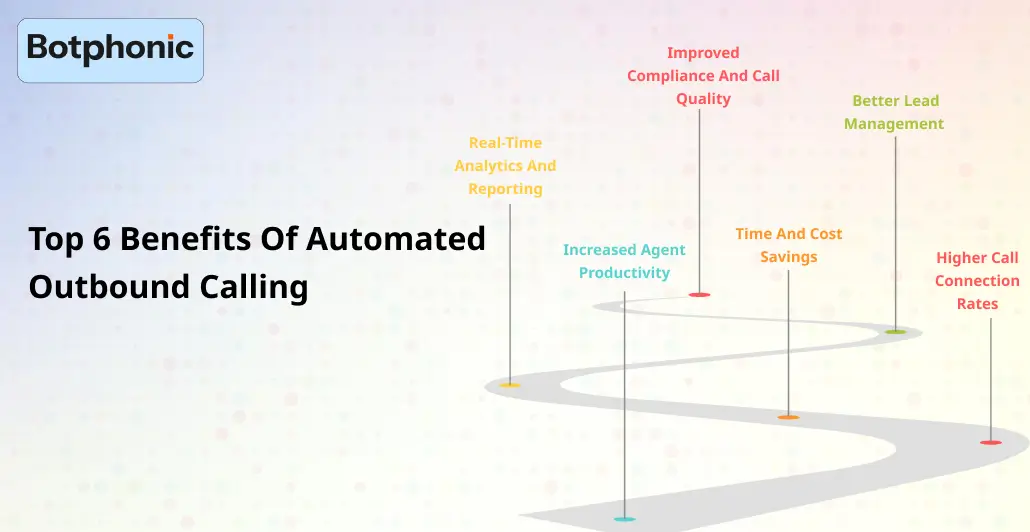
There are numerous benefits of using automated outbound calling in your business whether it’s a small business, a startup, or a large scale. It will only help you grow exponentially.
Let’s learn about some of the key benefits of using it.
1. Increased Agent Productivity
Using outbound call center automation software helps reduce downtime between calls and allows agents to speak with more potential leads in less time than expected, and maximizes efficiency.
2. Higher Call Connection Rates
With cloud-based phone systems and intelligent dialing modes, it’s easy for the system to skip unanswered or even busy lines and only connect to human reps when a real person answers.
3. Time and Cost Savings
Automation helps eliminate repetitive dialing procedures and, by automating voicemail drops and repetitive tasks, enables them to save time and lowers operational costs.
4. Real-Time Analytics and Reporting
You can opt for free call tracking software, which enables you to track key metrics like call duration, conversion rates, and even agent performance. Effectively optimize scripts, timing, and campaign data to adjust strategies.
5. Better Lead Management
Integrating CRM and other backend systems ensures that all call data is logged and makes it easiest to track lead status, schedule callbacks, and have follow-ups at the right time with relevant information.
6. Improved Compliance and Call Quality
Optimizing cloud-based contact center platforms enables you to utilize built-in compliance tools such as DNC filtering. Even the call recording feature helps you to meet legal requirements and maintain call quality standards.
These benefits make automated outbound calling a necessity for modern support teams. Even for call centers using outbound telemarketing services have become an essential part to scale smartly.
How to Set Up an Automated Outbound Calling Software?
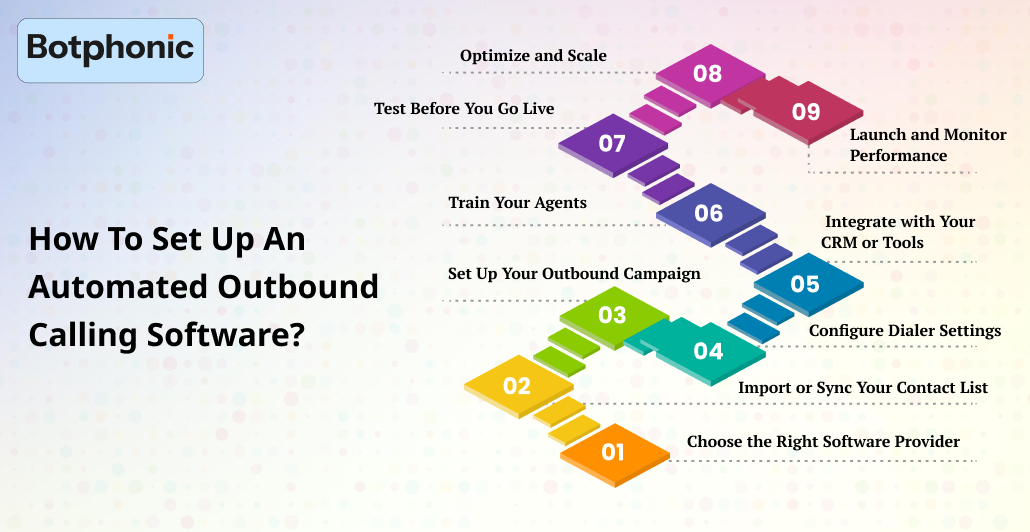
Setting up automated outbound calling software doesn’t have to be complicated. You can just follow a few simple steps and get your system running as smooth as butter.
1. Choose the Right Software Provider
Look for a platform that offers the features that you need for your task in hand. Ensure about the matter that you are facing whether it’s the dialing process, employee frustration over same questions, etc. See if the platform is offering tools, such as auto dialers, CRM integration, call tracking, etc.
2. Import or Sync Your Contact List
Upload your contact data directly, or just opt for sync to add it to your CRM. Segment the contacts in campaign type, lead stage, or even by the regions which are enabled for targeted calling.
3. Set Up Your Outbound Campaign
Add a new campaign in the system and ensure to define these for efficient working.
- Campaign name
- Assigned agents or teams
- Call scripts and templates
- Dialer Type
4. Configure Dialer Settings
Adjust your call settings as per your users’ preferences on how they like to be contacted. You can adjust settings like:
- Call pacing
- Retry attempts for unanswered calls
- Calls scheduling
5. Integrate with Your CRM or Tools
Link your software to other backend systems, CRMs, Emails, SMS, or even other help desk tools if available. It helps unify data, and personalized outreach, all while streamlining follow-ups.
6. Train Your Agents
Walk your agents through, using the platform, reading the dynamic scripts, and logging outcomes. Ensure that it can handle call flows.
7. Test Before You Go Live
Ensure to run a pilot test with a small segment, which will help you point out errors(if any). Check for:
- Call connections
- Script flow
- CRM data sync
- Recording data
8. Launch and Monitor Performance
Go live with your software and monitor it in real time. Use dashboards to track agent activity and call quality. It will also help you analyze the conversion rates and CSAT. You can make changes accordingly then.
9. Optimize and Scale
After monitoring the analytics, you can adjust script data or even the target audience based on performance data. Refining campaign timing can also enable you to scale successfully even with larger audiences.
What are The Criteria For the Right Automated Outbound Calling Software?
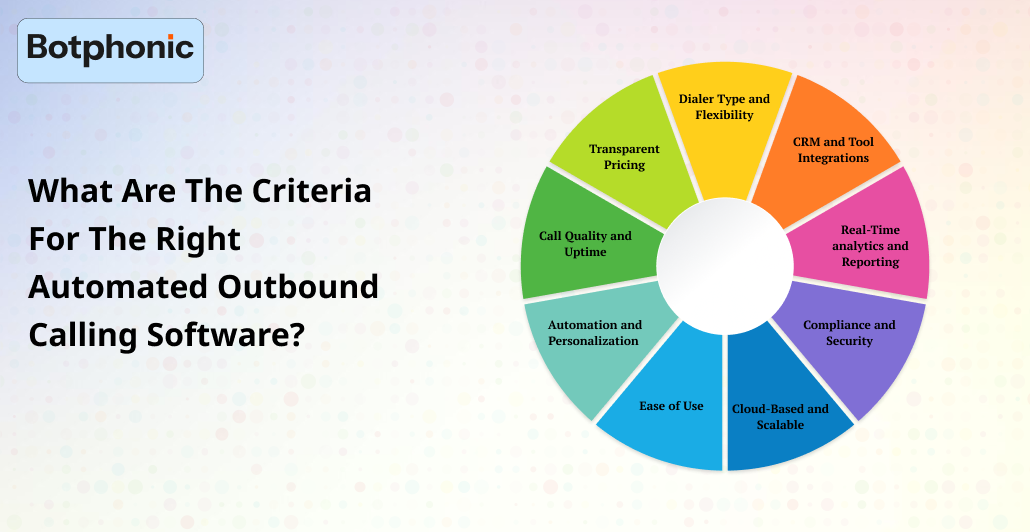
Choosing the right automated platform is essential to significantly enhance your outreach and promote success, agent productivity, and even a custom experience. Below is a focused list of key criteria to guide your selection:
1. Dialer Type and Flexibility
Look for software that offers multiple dialing modes, which match your strategy and campaign needs
2. CRM and Tool Integrations
Ensure there’s effortless integration with CRM, helpdesk, and other lead management platforms. It keeps the data centralized and efficient workflow.
3. Real-Time analytics and Reporting
The software should have inbuilt detailed dashboards and reporting about:
- Call volume and duration
- Agent performance
- Conversion and connection rates
- Campaign effectiveness
4. Compliance and Security
Select a platform that supports Do Not Call filtering, call recording disclaimers, and other regional compliance regulations.
5. Cloud-Based and Scalable
Using cloud-based contact center software offers flexibility and scalability even for remote teams as even for increasing call volume you won’t need other staff or other heavy IT infrastructure.
6. Ease of Use
The software should be made with a clean and intuitive UI with a simple workflow, even if it’s for campaign setup, contact upload, or script usage.
7. Automation and Personalization
Search for software who have features, such as:
- Automated voicemail drops
- Custom call scripts
- Smart call routing
- Call scheduling and rescheduling
8. Call Quality and Uptime
Always opt for providers with high call connection rates and global coverage to ensure the expected and consistent call quality.
9. Transparent Pricing
Look for a clear and scalable pricing structure that matches your team size and required features. Be cautious of hidden fees, which might or might not be included in the service level agreement.
Why Is Botphonic a Smart Pick for Your Business?
Botphonic is a modern yet powerful solution to your worries. It’s not just a simple solution but a smart and intelligent tool that helps you in one way or another. With AI call assistant and automations, it can handle thousands of calls at once, all while delivering consistent and human-like conversations. It can easily integrate with your CRM and customize campaigns and call flows, too. Botphonic helps with real-time analytics and scalable results, all while supporting your wallet.
Conclusion
Automated outbound calling software has become an essential tool that helps you scale effortlessly without needing to expand your call center team. Just knowing its benefits and adding the right platform to your business can help you grow, which will exceed even your expectations. Incorporating Botphonic can help you solve your worries about receiving customer calls and answering them even if it’s not business hours. It will always be there, just like a good supporting friend.

